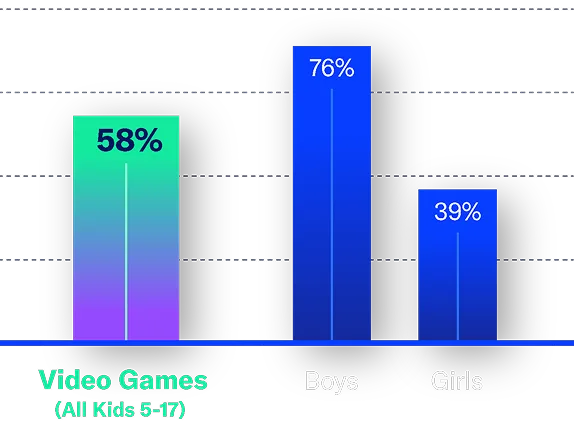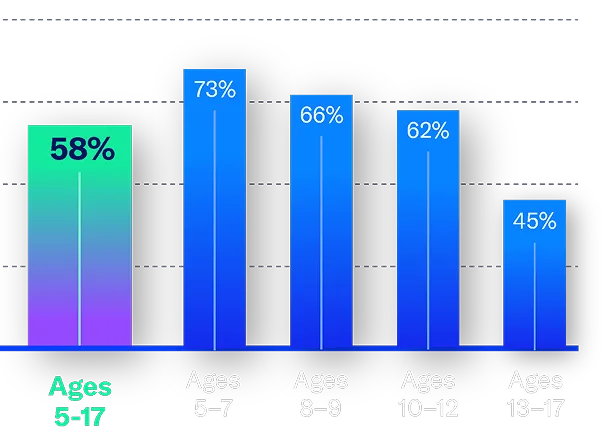
Three in five kids (ages 5-17) are asking for video games this holiday season.

Three in five kids (ages 5-17) say they want to play more video games with their parents.


Among parents who say they are planning to buy video game gifts this year, the average amount they intend to spend on video games is $736.83.

More than half of the 82% of U.S. parents* who play video games with their children say that games serve as a powerful tool for families to connect with one another.
*from the 2025 Essential Facts
The top five specific video game-related requests from children:

In-Game Currency: 43%

Video Game Console: 39%

Video Game Accessories: 37%

Physical Game: 37%

Video Game Subscription: 32%
Trust and Safety

Safe Gameplay: A Parent’s Guide to Holiday Gifting


ESRB rating information is located on the front and back of video game boxes and on product detail pages before purchase or download on digital storefronts. Parents can also look up rating information by conducting a search using a game’s title on ESRB.org and the ESRB mobile app. Many ratings include a Rating Summary, which provides greater insight into and examples of content in the game.
Did I check the game’s age rating and is it appropriate for my family?
The Entertainment Software Rating Board (ESRB) assigns age and content ratings for video games and mobile apps to help parents decide which are appropriate for their kids. According to research from ESRB conducted by Hart Research Associates, more than three in four parents regularly use ESRB ratings. Parents have the key information they need with ESRB’s three-part rating system, consisting of:
Age Rating categories that suggest a game’s age appropriateness. Age ratings include E for Everyone, E10+ for ages 10 and older, T for Teen, M for Mature for ages 17 and older or AO for Adults Only. Most video games have content that is appropriate for kids – of the ESRB ratings assigned to games in 2024, 89% were rated E, E10+ or T.
Content Descriptors highlight the content that may have influenced the assigned age rating. ESRB has more than 30 content descriptors to let parents know if a game includes language, suggestive themes, violence and more.
Interactive Elements provide upfront notice about interactive or online features but do not influence the rating assignment of a game. This includes user-to-user communication or whether players can spend money inside the game.
ESRB rating information is located on the front and back of all video game boxes and on product detail pages before purchase or download on digital storefronts. Parents can also look up rating information by conducting a search using a game’s title on ESRB.org and the ESRB mobile app. Search results include Rating Summaries that provide more detailed information about the content of a game and the context in which it is experienced by the player (rating summaries are only available for physical games sold in stores).
Have I set up parental controls on my game device?
Four in five parents of kids ages 5-9 use parental controls on some or all of the devices their kids use to play games, and 92% require their kids to get approval before making in-game purchases. Tools exist on virtually all game devices to help parents, caregivers, and players easily and efficiently manage the gameplay experience.
Parental controls can:
- Filter games by age rating
- Manage time spent playing games
- Control – or prevent – spending
- Limit – or block – communication with other players
- Use PIN and password settings to prevent unwanted changes
- Provide parents with regular playtime reports

Also, be sure to always enter accurate birthdays for your children when signing up for a new platform, game or service. In addition to protecting your kids’ private information, doing so can ensure that default safety settings are activated for your children’s accounts.

“Video games are one of the most popular forms of entertainment in the world today, with more than 205 million Americans powering up games every week to have fun, relax and connect with friends and family,” said Stan Pierre-Louis, president and CEO, Entertainment Software Association. “Our research this year shows that kids not only want games, they also want quality time with their families. In a world where people feel increasingly disconnected, playing video games remains one of the easiest – and most fun – ways to stay close to the people we love.”
Have I had a conversation with my child(ren) about playing online with other people?
A growing number of games allow players to interact with others online, which can be a fun way to stay in touch with friends and family who live further away. Families should decide if this is allowed in their household and, if not, buy single-player games or use parental controls to limit or block interactions with other players.
If children are allowed to interact with others online, discuss appropriate behavior, like treating other players kindly and respectfully, and have conversations with children about interacting with strangers so they know what to do if they encounter inappropriate behaviors online. Remember: kids can always mute, block and report a player and, if they’re unsure about someone’s actions, they can talk to a trusted adult for advice. Kids should never move a conversation with someone they meet on a game platform to another chat service.
To learn more about facilitating conversations around video games in your home, visit ParentalTools.org and follow the ESRB blog. Steps the video game industry is taking to help protect its player community can be found on the ESA website.
“Start a conversation with your kids about how to play responsibly,” said Alanna Powers, Research and Program Specialist, Family Online Safety Institute (FOSI). “You can check out FOSI’s Unlocking Video Games resource and Safer Gaming Guide for tips on how to initiate this conversation. I encourage parents to play games with their children to learn about their interests. When parents give their child a video game related gift for the holidays, they may also be giving the gift of family bonding. Check out our FOSI Holiday Gift Guide: Tech Edition for more tips on digital parenting during the holidays.”
2025 Holiday Survey Methodology
YouGov and ESA conducted a 5-minute online survey in the U.S. from September 26-30, 2025 among 1,912 respondents ages 5-65 recruited from YouGov’s proprietary online panel. Data is weighted to be representative of the overall U.S. population in terms of age, gender, ethnicity, education and census region. Respondents ages 5 to 17 were asked to complete the survey under the supervision of a parent.
Explore these steps the video game industry is taking to help protect its player community.
Codes of Conduct
Guidelines and community standards establish acceptable behaviors.
Human Oversight
Trained individuals help moderate conduct and content in gaming environments.
Parental Controls
We provide parents and caregivers with comprehensive information and tools they need to decide which gameplay experiences are appropriate for their children.
Partnerships
Video game developers, publishers and platforms collaborate to promote trust and safety in the player experience.
Player Controls
The video game industry empowers players with the tools and information necessary to manage their gameplay experience on screen.
Promoting Positive Play
Video game communities benefit from environments that encourage sportsmanship, camaraderie and mutual respect.
Technology
Advanced technologies help prevent harm before it happens.
